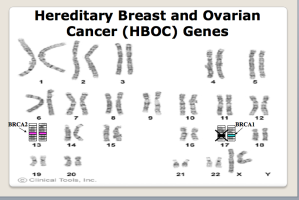You can read about Angelina Jolie and The Dirty Little Secret of the BRCA related cancers on More.com
No one wants to hear that they have breast cancer. Many women don’t really want to know that is not “if they will get breast cancer”, but “when they will get breast cancer.” Our mothers and grandmothers didn’t have the choice to know if they were carriers of the BRCA variant genes when they were young as the testing did not exist. What they didn’t know did hurt many of them but they didn’t have the difficult decisions to make about their futures that
We do!
If it could tell us the day before the cells decide to stop dying at the appropriate time and cancer was beginning its uncontrolled cell division. We would choose not to get breast cancer. We are able to choose the pair of jeans to house our legs, but we have no choice over the pairs of genes that make up our DNA. ( at least not yet!)
The BRCA I and II hereditary breast and ovarian cancer genes are the genetic variants that we know of at this time that are the most common genetic mutations that cause and increased risk of breast and ovarian cancer. Who’s at risk? Great question. There are several red flags that alert us as clinicians to offer testing to individuals who have a significant risk of carrying on of these genetic variants.
•Personal history of breast cancer < age 50 years
•Family history of multiple cases of early onset breast cancer
•Ovarian cancer (with family history of breast or ovarian cancer at any age)
•Breast and ovarian cancer in the same woman
•Bilateral breast cancer or 2 primaries in same breast
•Ashkenazi Jewish heritage any age ( 1/40 AKJ individuals carry the gene compared to 1/500 non AKJ)
•Family history of male breast cancer any age
•ER-, PR-, Her 2 neu- ( aka triple negative breast cancer) < 60
•Personal hx Pancreatic cancer any age with 2 close relatives with breast/ ovarian or pancreatic CA any age
•Limted family structure ( adoption, death of women by 45)
If you feel that you fit the above criteria, talk to you healthcare provider to be referred to a physician or genetics counselor to discuss your personal family pedigree and determine if testing is right for you.
If you are found to carry one of the variant genes, you are at increased risk for breast and ovarian cancer
Making a decision to have risk reduction surgery is personal and you are the one who has to live with that decision every day. Everything in life has risks and benefits and all of them need to be taken into consideration when a decision is made. Many women chose to have close clinical surveillance with mammograms, MRI’s and clinical breast exams. Tamoxifen, an estrogen blocker can decrease the risk of an estrogen sensitive breast cancer by nearly 50%. We have innumerable patients who are followed clinically and they are quite comfortable with their decision.
BRCA gene-related breast cancers are associated with a high incidence of triple negative tumors. These are fast growing cancers that can appear suddenly as large tumors in just a few months. BRCA positive patients follow a six month screening routine alternating between mammogram and MRI. Triple negative cancers can pop up in the interval between screening exams. This is one reason that more and more women who carry a BRCA gene choose to have risk reduction surgery with reconstruction. Surgically, we are often able to preserve the nipple complex providing patients with risk reduction and excellent cosmetic results. Triple negative cancers account for approximately 75% of the cancers that occur in BRCA I carriers and 30% of the cancers in BRCA II carriers. (Less then 11% of breast cancers in the general population are triple negative.) These cancers are fast growing, aggressive, and almost all require chemotherapy as they lack certain cell surface proteins that can be targeted by medication such as Tamoxifen.
So what’s the buzz on ER-, PR-, Her 2 neu- aka triple negative breast cancer.
Triple negative breast cancers are cancers that begin in the breast and do not have cell surface proteins that receive signals that can either stimulate or block the cells production. Triple negative is short for ER- (estrogen receptor negative), PR- (progesterone receptor negative) HER 2 neu – (Human epidermal growth factor receptor 2 negative). This means that these tumors lack those cell surface proteins therefore specific targeted treatments will not work in these tumors.
Triple negative breast cancers account for only 10-15% of all breast cancers. Triple negative cancer growth is not stimulated by the hormones estrogen and progesterone, therefore medications to block those receptors will not work in triple negative breast cancer. Herceptin is another “targeted” therapy but is ineffective in Her 2 neu negative tumors as the cells lack the Her 2 neu surface protein.
Triple negative breast cancers are also considered to be more rapidly growing tumors and therefore need to be treated aggressively. They are often call “interval cancers” as they can develop and grow to be quite large (3-4 centimeters, the size of a small lemon) between annual mammograms. The risk of recurrence for triple negative cancers is significantly higher within the first 2 years after the initial diagnosis, and decreases after this time interval. Hormone positive cancers however, may not recur for 5-15 years after their initial diagnosis.
Triple negative breast cancers are frequently seen in younger women, although the distribution is similar in all age groups. African-American women are twice as likely to develop a triple negative breast cancer. These tumors are also more likely to be associated with the BRCA I and BRCA II breast and ovarian cancer genes. Approximately 75% of BRCA I carriers and 30 % of BRCA II carriers who develop breast cancer will have a triple negative cancer. For those reasons women who develop this subtype of cancer need to be tested for the BRCA genes.
The local, or breast and lymph node, treatment of triple negative breast cancer is the same as any other breast cancer. Breast conservation therapy, lumpectomy and radiation, or mastectomy with reconstruction both with evaluation of the lymph nodes is the options. One important difference, however, is that research has shown that triple negative breast cancers are very responsive to chemotherapy, thus making this treatment option a cornerstone of triple negative breast cancer therapy even with very small tumors that do not involve the lymph nodes. While chemotherapy is not always a part of the multi-disciplinary care associated with hormone positive breast cancer, along with surgery and radiotherapy, it is an integral part of the treatment of triple negative breast cancer. Neo-adjuvant chemotherapy, or chemotherapy before surgery, is also frequently used for treatment of triple negative breast cancer to shrink the tumor to allow for better breast cosmetic outcomes.
Triple negative breast cancer has a lower survival rate than other breast cancers. Many factors play into survival rates. According to studies cited at Breastcancer.org, women with triple negative breast cancer have a five-year survival rate of 77 percent, compared to women with other subtypes of breast cancer, who have a five-year survival rate of 93 percent. Having a triple negative breast cancer does appear to raise the risk of death within five years of diagnosis compared to women with other subtypes of breast cancer, but after that five-year time period, the risk diminishes. Unfortunately, mortality rate among African-American women with triple negative breast cancer is much higher than it is in Caucasian women.
If you or a family member has been diagnosed with a triple negative breast cancer, take a deep breath and know that this cancer is treatable! My advice is that although this is an aggressive subtype of breast cancer, there are combination therapies for this particular tumor type that offer her a potential long-term survival equivalent to stage matched hormone positive breast cancers when diagnosed early and treated aggressively. Know that chemotherapy is a cornerstone of treatment and that frequently chemotherapy is given in advance of other therapies such as surgery and radiation therapy. A team of doctors, including a breast surgeon, a medical oncologist, a radiation oncologist, and frequently a genetic counselor will be involved in the multi-disciplinary care of her health through this difficult time in her life. Genetic testing and counseling are a must!
OVARIAN CANCER RISK
BRCA carries have a 44% risk of developing ovarian cancer by the age of 70. We cannot gloss over the risk of ovarian cancer in this conversation as the ovaries are hidden away in our abdominal cavity and are virtually impossible to screen for cancer. Ovarian cancer strikes silently therefore it is recommended that women who have had their children and carry the BRCA I or II gene have their ovaries and tubes removed at a time determined by their physicians based upon several personal factors. Their risk after removal goes from 44-50% down to 4%. ( The risk is never zero as our abdominal cavities can still produce some progenitor cells that can turn into cancer. < aka primary peritoneal carcinoma>)




Excellent article!
So much useful information is dispensed in this eloquently written article. I carry the BRCA2 gene mutation and have opted for risk reduction surgery. I am forwarding this article to every woman I know to heighten their awareness and understanding of what it is like to be living in my “GENES.”